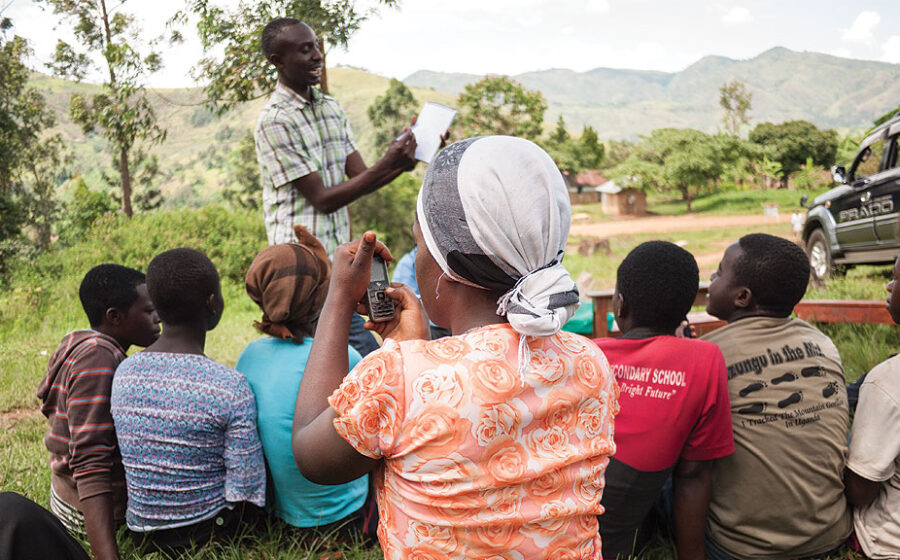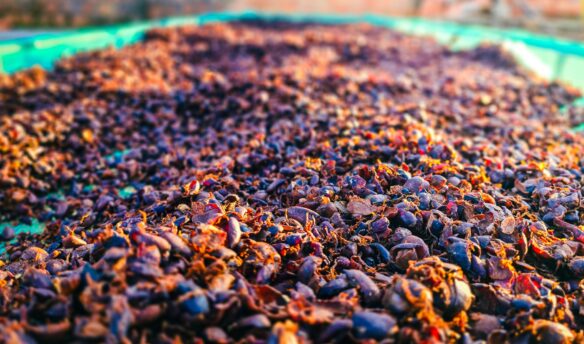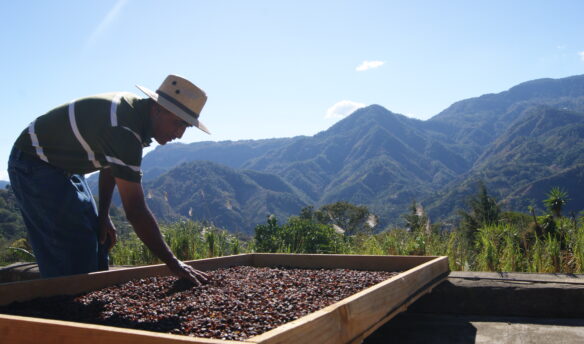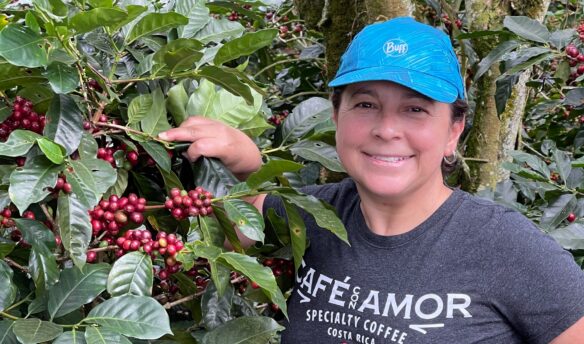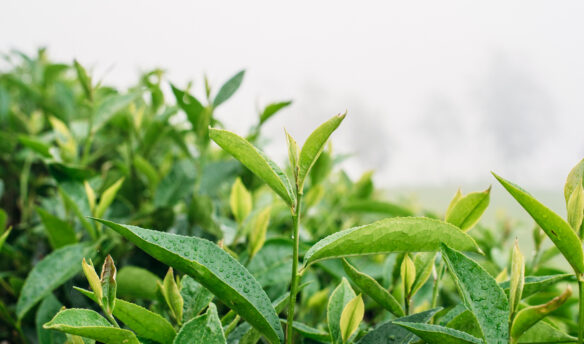[T]he prevalence of specialty coffee continues to drive consumer interest in both bean quality and ethical sourcing. Many coffee drinkers associate higher-priced beans and upscale retail experiences with greater social and environmental responsibility at the farm level. However, the growing number of ways in which sustainability is marketed to consumers can create confusion and differences of opinion around what sustainability actually means. Even for specialty roasters who maintain long-term relationships with individual farms, it’s difficult to know how much information to share with consumers about trade relationships or a producer’s agricultural practices.
Mainstream consumers are more receptive than ever to learning about social and environmental issues in coffee production—the expectation for transparency from roasters is high, but the opportunities to become involved in solutions to these issues are increasing. The entire industry has a responsibility to support the development of new strategies helping growers adapt to climate change. New pest and disease threats, variable weather patterns, and rising temperatures are expected to have a disproportionate impact on smallholder farmers in the years ahead, threatening yields and economic productivity on both large and small farms around the globe. Solutions to these challenges will require creative thinking at every stage in the supply chain.
Several new technologies are impacting how coffee is grown, processed, transported, and sold—and hold the potential to link farmers with socially and environmentally minded consumers in completely new ways. Technological innovations are combining the latest in data science and materials science with existing strategies such as integrated pest management (IPM) to help farmers lower their input costs, reduce the risk of crop loss, and bring more financial security to rural communities.
How will emerging technologies change our ideas about sustainability in the twenty-first century?
Big data meets smallholders
While the “connected farm” is still many years away, several innovations in agricultural technology (ag tech) can help growers monitor field conditions, manage resources more efficiently, and reach new markets.

The most revolutionary tool for economic growth in many coffee-growing regions could be the cell phone. Since 2013, Facebook has earned headlines (both positive and negative) for its bold attempts to bring broadband access to the developing world. In the meantime, lower-tech solutions are taking off, bringing critical information about weather, market prices, and pest management strategies to help farmers optimize management decisions with limited resources.
WeFarm uses cell phones to connect smallholders through mobile apps and peer-to-peer networks; users communicate through text messages to share information about farming practices and business development. Texting might seem less influential than broadband; however, it reflects a technological leap for many in the world’s remote coffee-growing regions. WeFarm has found early success because of its community-based approach: technical expertise comes directly from farmers themselves. The startup’s peer-to-peer format has been particularly beneficial for female smallholders who do the majority of physical labor on coffee farms, but whose access to land rights and financial resources has historically been limited in their communities.
Other developments hold promise to help farmers connect with new markets and provide consumers with a more complete window into how much of their dollar goes back to origin. One of the most promising approaches to improving supply chain transparency as well as farmer income comes from blockchain, the technology behind bitcoin.
At a basic level, a blockchain is a collection of data packages stored in “blocks” that are “chained” together into a distributed ledger (see below for more on blockchain basics). Data entered into the blockchain cannot be changed without approval from all parties. Any changes are recorded, and every participant in the value chain maintains access to the same information. This creates a fully traceable, secure digital passport for any physical object moving around the world. It is an entirely new approach to delivering traceability, provenance, and authenticity.
The potential applications of blockchain are endless and extend throughout the coffee value chain. For smallholder farmers who are named beneficiaries of several different governmental and NGO programs simultaneously, blockchain could reduce the volume of redundant information that is collected about them. Over time, blockchains could help smallholders “own” their economic identity and create a track record of milestones, which could improve their access to credit and farm insurance.
For large commercial buyers of coffee, blockchains could reduce the risk of fraud and exploitation by creating more reliable audit trails, reducing transaction costs, verifying seller identities, and improving consumer confidence in third-party certification procedures. It could also reduce the industry’s reliance on anecdotal information about issues that matter to consumers, such as fair labor practices and living wages.
Buyers of specialty green coffee beans could guarantee the quality and traceability of micro-lots from individual farmers, estates, or cooperatives. On the retail side, blockchain could help marketers reach consumers who are interested in more nuanced certifications—such as Bird Friendly coffee—with 100 percent confidence that producers have followed strict guidelines for the entire lot.
Ag tech startups are paving the way for a dramatic shift in how farmers manage operations and connect with buyers. Once global broadband is available, coffee farms could see a host of new tools including drones, geographic information systems (GIS), hyperspectral imaging, remote sensing, and even artificial intelligence. These technologies are still early in development but could lead to greater social and environmental responsibility throughout the industry in the coming decades.
Improvements to plant genetics
The coffee berry borer and coffee leaf rust are persistent threats to farmers around the globe, often resulting in devastating crop losses. Several technologies are delivering new insights into how pests and plants interact and improving our ability to optimize unique varietals with diverse microclimates.
As a species that accounts for over 70 percent of the world’s coffee production, Coffea arabica holds the key to improving our knowledge of how plants respond to different stressors. Researchers at UC Davis recently sequenced the genome for arabica and released it to the public on Phytozome, an online portal run by the Department of Energy’s Joint Genome Institute. Meanwhile, World Coffee Research, an industry-funded organization, is applying big data to traditional breeding methods to identify and breed new hybrids that can sustain high yields in an increasingly variable climate.
CRISPR-Cas9, the gene editing tool developed in 2012 that has received extensive press for its value to biomedical research, gives plant breeders an additional method to introduce new varietals that can withstand the impacts of climate change. Breeders could use CRISPR in many different ways to help reduce the economic damage of the coffee berry borer or coffee leaf rust—and even breed for specific flavor compounds that have high value in specialty markets. Its power comes from speed, precision, and ease of use, allowing breeders a more efficient way to disable genes or add a new patch of DNA to a genome.
Improved knowledge of how coffee plants behave in different environments, combined with the tools to modify them to adapt to a changing climate, will be essential to meet growing global demand for coffee in the coming decades. For the coffee industry, these new tools could amount to a significant improvement over standard cross-breeding and open new markets for cultivation beyond the bean belt.
New innovations in materials science
Like other crops grown in tropical areas, most coffee production currently relies on extensive use of generic, off-patent chemicals to minimize pest and disease damage during a growing season—often with substandard protective measures for field workers. New approaches to pest and disease control will be necessary as climate change threatens coffee farms and rural livelihoods around the globe.

One strategy comes from Crop Enhancement, a Cambridge, Massachusetts–based startup (where I serve as CEO). In our mission to improve social, environmental, and financial outcomes in the world’s tropical regions, we’ve looked in part to the field of material science for strategies. We asked: how can we help farmers sustain high yields while reducing their pesticide exposure? We’ve developed a non-toxic, biodegradable crop-protection product, called CropCoat, which forms a film that coats plant surfaces such as leaves, stems, and fruit to reduce the need for harmful pesticides. CropCoat can be used on its own or combined with active ingredients including biological controls such as beneficial bacteria, fungi, and viruses to combat pests like the coffee berry borer, which is conservatively estimated to cause $500 million in economic damage to coffee farmers globally each year. In addition, CropCoat can also mitigate coffee leaf rust.
The coffee berry borer presents a unique challenge for farmers: most of its life cycle occurs inside the coffee berry, making it impossible to spray our way out of the problem with conventional pesticides. Once a tree has been infested, the female bores into a host berry and deposits eggs inside the seeds (i.e. the coffee beans), where larvae then mature, resulting in a decline in both coffee quality and yields.
A fungus called Beauveria bassiana is extremely effective at killing the coffee berry borer and is commercially available as a biopesticide. However, Beauveria bassiana is short-acting and frequently washes off of crops in tropical areas with heavy rains. This is where CropCoat can help maximize the efficacy of biological controls. Early field trials suggest that combining CropCoat with the beetle-killing Beauveria bassiana can interfere with the pest’s ability to bore into the coffee berry.
CropCoat can be applied on its own as a microlayer to trees, helping farmers improve crop quality and yield while reducing the frequency of pesticide applications throughout a growing season. It can also be used as a delivery vehicle for active ingredients of both organic and synthetic products, including growth regulators and pheromones. CropCoat is one of many cost-effective innovations that can help reduce overall pesticide exposure for smallholding farmers and rural communities—it provides crop protection for up to eight weeks and can be applied with existing backpack sprayers, making it particularly well suited to minimizing excessive spraying in tropical regions with heavy rainfall.
Bringing sustainability and quality to consumers
As innovations take place throughout the coffee value chain, consumers are becoming increasingly aware of the challenges ahead for coffee production, and are eager to put their dollars to work. Interest in transparency is growing: roasters who have traditionally relied on third-party certifications as a stamp of approval are encountering demand for information beyond what a label can offer. As new technologies, ranging from genome research to CropCoat, achieve meaningful improvements on the ground, both commodity and specialty producers have an opportunity to define sustainability in more concrete terms—and to invite the consumer to take more interest in the coffee’s journey from farm to cup.

WHAT IS BLOCKCHAIN?
Blockchain evolved from bitcoin technology, a network solution devised to increase transparency of online transactions. Instead of requiring a centralized intermediary (e.g. a bank) to approve transactions—which blocks out a user’s access while transactions are being approved—bitcoin works by recording transactions on a public ledger accessible to all computing devices that are part of the network. When a transaction is initiated, a “block” enters the system and is broadcast to the peer-to-peer computer network of users for validation. All users are privy to each transaction, which prevents stealing and double spending (duplicate transactions).
The technology is similar to a Google Doc, which allows multiple users to access a document at the same time. Instead of creating multiple versions of a document in the process of sending revisions back and forth, all users have access to the most updated version of the document and can see changes in real time. This is how distributed ledgers work. Each transaction becomes a block in the chain, resulting in a transparent record (this is kind of like being able to see a list of all revisions made to a Google Doc).
Blockchain uses bitcoin technology for the transfer of data, which is why it’s useful for improving transparency in the coffee industry. Records are stored in a distributed ledger (a public forum instead of the bank-like intermediary), so records are public and easily verifiable. Blockchains are hosted by millions of computers simultaneously, so data is accessible to anyone on the internet. The network reconciles every exchange of data in ten-minute intervals, providing a secure, traceable record of digital information exchange.
—Kevin Chen, Ph.D, is the CEO of Crop Enhancement, the Cambridge, Massachusetts-based venture-backed agriculture technology corporation. You can reach him at kchen@crop-enhancement.com
or on Twitter @kevmchen.



